
September/October Issue of Vein Specialist
The Crucial Role of Arterial Testing in Managing
Wounds from Chronic Venous Insufficiency

Jeffrey Silpe, MD, MS-HPEd
Associate Program Director, Vascular Fellowship and Residency
Assistant Professor of Surgery
Zucker School of Medicine at Hofstra/Northwell

Yana Etkin, MD, FSVS, FACS
Associate Chief, Vascular & Endovascular Surgery
Program Director, Vascular Residency & Fellowship
Associate Professor of Surgery
Zucker School of Medicine at Hofstra/Northwell
Chronic venous insufficiency (CVI) affects more than 25 million adults in the US, often leading to painful and non-healing wounds. Patients with CVI may experience symptoms like swelling, aching, and the development of skin ulcers. While addressing superficial venous reflux is essential for managing CVI, assessing and treating arterial insufficiency before proceeding with venous treatments should not be overlooked.
Understanding the Connection
Wound healing is a complex process that requires adequate blood flow. In CVI, the veins do not adequately return blood to the heart, which can lead to pooling and swelling in the lower extremities. However, arterial insufficiency, where the arteries fail to deliver sufficient oxygenated blood to the tissues, can complicate matters significantly. When both venous and arterial issues coexist, the healing process is severely hampered.
Patients with CVI often have undiagnosed arterial insufficiency. In fact, studies suggest that up to 30% of people with leg ulcers have compromised arterial circulation. Without proper evaluation, clinicians may assume that treating the venous reflux alone will promote healing, but this is rarely the case when arterial flow is impaired.
The Importance of Testing
Testing for arterial insufficiency typically involves a non-invasive assessment called an Ankle-Brachial Index (ABI), which compares blood pressure in the ankle with that in the arm. This simple test can reveal whether patients have sufficient blood flow to support wound healing. In cases where arterial insufficiency is present, further imaging studies may be necessary to assess the severity and location of the blockage.
Identifying arterial issues before initiating treatment for venous reflux is essential. If a patient has poor arterial circulation, treating the venous reflux may not yield the expected outcomes, and the wound may continue to deteriorate. Therefore, a comprehensive approach that includes arterial testing is vital for optimizing patient care.
Integrating Treatment Approaches
Once arterial insufficiency is identified, treatment options can vary. In some cases, lifestyle modifications such as smoking cessation, exercise, and dietary changes may improve arterial health. In more severe cases, interventions like angioplasty or bypass surgery may be necessary to restore adequate blood flow.
After addressing any arterial concerns, clinicians can then focus on treating the venous reflux, often through methods like compression therapy, thermal or non-thermal venous ablation, or surgical interventions. This sequential approach can significantly enhance the chances of successful wound healing.
Conclusion
For patients grappling with wounds related to chronic venous insufficiency, the road to recovery is multifaceted. By prioritizing the assessment and treatment of arterial insufficiency, healthcare providers can ensure a more effective and holistic approach to healing. Patients should be proactive in discussing their vascular health with their clinicians and emphasize the importance of comprehensive testing. Only through a thorough evaluation can we pave the way for successful wound management and improved quality of life for those affected by CVI.
Advocating to Improve Wound Care:
AVF and the Alliance of Wound Care Stakeholders

Marcia Nusgart, RPh
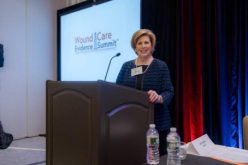
Medicare coverage and payment regulations dictate which products and services clinicians can provide to patients. The Alliance of Wound Care Stakeholders, in which AVF is an active member, is a watchdog of Medicare policies – with a laser focus on the effect of policies on wound care. With medical specialty societies, provider groups, wound clinics, and business entities as members, the Alliance brings together diverse stakeholders to advocate on coverage, coding, and payment policy issues that may create barriers to patients’ access to care. The Alliance has made its collective voice heard on a range of issues relevant to AVF and vein specialists, including:
Protecting Clinician Payment: Medicare Fee Schedule
For years, inadequate Medicare Physician Fee Schedule payment rates have strained physician practices and created barriers to care for beneficiaries. As in past years, physician pay cuts are again proposed in the draft 2025 Medicare Physician Fee Schedule released for comment. As payments fail to keep up with practice costs, the Alliance, along with AVF and hundreds of medical specialty organizations, has given voice to the effect of these ongoing cuts on undermining the long-term financial viability of office-based physician practices and the effect this will have on seniors’ access to services and treatments.
We have elevated this issue beyond CMS and taken it to Congress. The Alliance joined with hundreds of other clinician associations in letters to Congressional representatives and committees urging Medicare payment reforms. Along with AVF, we have been on the record supporting legislation like the “Providing Relief and Stability for Medicare Patients Act” that would implement yearly inflationary updates for Medicare physician payment. How have cuts affected your practice and the care you’re able to provide? Inform your Congressional representatives directly via the email advocacy tool that that AVF created.
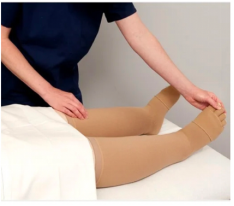
Seeking Fair Reimbursement: Lymphedema Compression Treatment
The Alliance– together with the AVF and lymphedema patient/provider community– celebrated when the Lymphedema Treatment Act was passed into law in late 2022 mandating Medicare Part B coverage for compression garments for the treatment of lymphedema and enabling lymphedema patients whose wounds have healed to gain access to compression stockings (previously, Medicare required a debrided wound to cover these garments). Throughout 2023, the Alliance educated CMS policymakers on the fitting and application process for these garments, with a focus on the need for additional CPT procedure codes and payment to account for the time and expertise required by clinicians. These codes were not, however, included in the initial policies implementing the Act. This remains an area of mutual interest and advocacy attention across our organizations as we continue conversations with CMS on this issue.
Streamlining Prior Authorization
Both AVF and the Alliance have pushed back against burdensome Prior Authorization (PA) rules of Medicare Advantage programs. The Alliance submitted recommendations to CMS’ “Advancing Interoperability and Improving Prior Authorization Processes” proposed rule last year. We are pleased to share that looking ahead, PA improvements are included in CMS’s proposed 2025 Hospital Outpatient Prospective Payment System, which includes provisions to align PA timelines in this setting (currently 10 days) to the Agency’s managed care regulations (7 days). This improvement will be of particular interest to vein specialists, as vein ablation currently requires prior authorization.
“The Alliance is a unique organization in the way it brings together clinical organization and industry with policy makers and payers to find common ground and to work to ensure access to care for our patients .”
-Dr. Mark Iafrati, AVF Board Member and representative to the Alliance of Wound Care Stakeholders
Protecting Access: CTPs
A recent issue of concern has been policies restricting access to cellular and/or tissue-based products (CTPs or “skin substitutes”) for diabetic foot ulcers and venous leg ulcers following the Spring 2024 re-release of a series of draft Local Coverage Determinations (LCDs) that could dramatically affect Medicare Administrative Contractors’ (MACs) coverage of these products. With only 15 product HCPCS codes included in the proposed policies, coverage is removed from a significant number of commonly used products that are currently reimbursed by Medicare. Similarly, the draft policies permit only 4 applications of CTPs in a 12-week treatment period, but – after stakeholder outcry on earlier drafts – now allow for additional applications or an extension of the treatment period when medically necessary. The Alliance has been a vocal advocate in this area and has provided recommendations to each of the MACs, to CMS, and to Congress to make sure that wound healing outcomes are not compromised, evidence-based medicine is used, and patient care is protected. The final LCDs have not yet been released and the MACs are currently evaluating the thousands of comments submitted.
Protecting Access: Surgical Dressings
When the Alliance was alerted about claims processing issues and denials that were increasingly creating a lack of patient access to surgical dressings, we elevated the issue. Following a series of letters and meetings with the DME Medicare Administrative Contractor Medical Directors addressing denials for alginate or other fiber gelling dressings, modifier quantity limitations, and a lack of alignment in the claims processing system with the HCPCS codes and modifiers when a dressing is used for multiple wounds, policy revisions were enacted! An updated surgical dressing policy article published in February addressed many of the issues that were creating barriers to access.
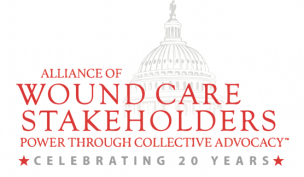
Change Happens When We Work Together
Advocacy is a long game that requires strategy, tenacity, proactivity, and being consistently on the record as policies evolve. Elevating and leveraging our collective voice is crucial to ensuring that wound care has visibility and a seat at the regulatory table during healthcare policy development. With the upcoming presidential election and ongoing evolution in US healthcare priorities, rest assured that the Alliance will continue to serve as a watchdog tracking policies and bringing the voice of wound care to relevant policy issues. Stay involved and make your voice heard– with your local and national professional associations–and/or with the Alliance! Ultimately, the real winners of advocacy are Medicare beneficiaries with chronic wounds who, because of effective advocacy, avoid unnecessary barriers to treatments and services that can support wound healing.
A Message from the Wound Healing Society
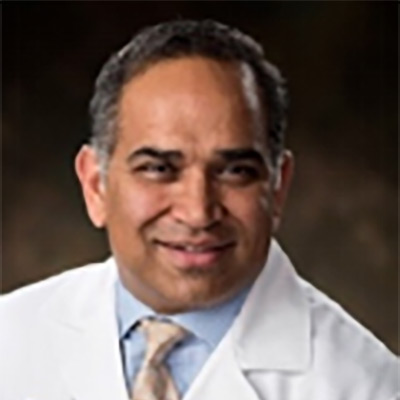
Sundeep G. Keswani, MD, MBA, FACS
Dear AVF Members and Friends,
The Wound Healing Society (WHS) is honored to contribute to this issue of Vein Specialist. As the leading organization dedicated to advancing wound care and the science of wound healing, WHS unites clinical providers, researchers, and educators with a shared commitment to improving patient care through research, education, innovation, and advocacy.
Membership Benefits
WHS members enjoy a 20% discount on registration for our annual meeting (WHS/SAWC Spring), providing an excellent opportunity to stay at the forefront of wound healing advances. Members also receive a 15% discount on the Wound Certification Prep Course, helping to enhance their expertise and credentials. Subscriptions to the Society’s Journal, Wound Repair and Regeneration (WRR), and discounted access to the Advances in Wound Care journal ensure members are well-informed with the latest research and developments. Additionally, members benefit from one complimentary job posting, participation in influential surveys and reports that affect regulatory decision-making, and exceptional networking opportunities with leaders in clinical wound healing research, industry, and healthcare policy.
How AVF Members Can Get Involved
Joining WHS opens doors to a wealth of resources designed to support your professional growth and contribution to the field of wound care. Whether you are interested in research, clinical practice, or education, WHS provides platforms for collaboration and innovation. Our meetings and grants offer invaluable opportunities for learning and networking.
Patient Testimonials
Many patients have experienced life-changing improvements through the work supported by WHS. One patient shared, “After years of suffering from chronic leg ulcers, the treatments developed through WHS research have finally given me relief and a better quality of life.” Another noted, “The advances in wound care have been remarkable, and the dedicated professionals at WHS are truly making a difference in patients’ lives.”
We invite AVF members to join WHS and be part of a vibrant community dedicated to improving wound care worldwide. Your involvement and support are crucial in advancing our mission to enhance patient outcomes and foster innovative solutions in wound healing.
Thank you for considering this invitation. We look forward to the potential collaboration and the collective advances we can achieve together.
Sincerely,
Sundeep G. Keswani, MD MBA, FACS
Wound Healing Society President
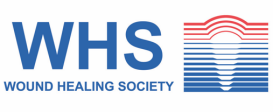
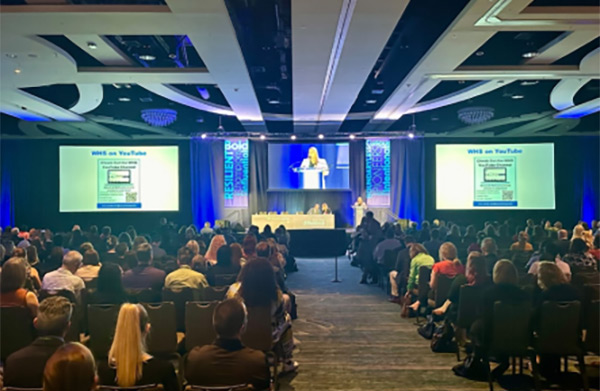
WHS Past President Traci Wilgus at WHS/SAWC opening ceremony , Spring 2024.

WHS Member Social Event 2023


